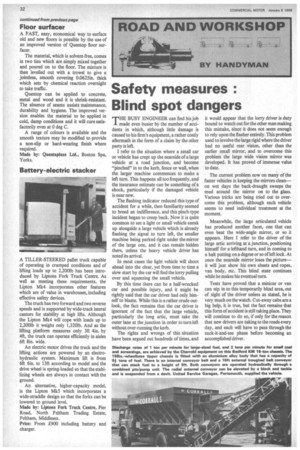Safety measures : Blind spot dangers
Page 34

If you've noticed an error in this article please click here to report it so we can fix it.
'T'HE BUSY ENGINEER can find his job -1 made even busier by the number of accidents in which, although little damage is caused to his firm's equipment, a rather costly aftermath in the form of a claim by the other party is left.
I refer to the situation where a small car or vehicle has crept up the nearside of a large vehicle at a road junction, and become "pinched" in to the kerb, fence or wall, when the larger machine commences to make a left turn. This happens all too frequently, and the insurance estimate can be something of a shock, particularly if the damaged vehicle is near new.
The flashing indicator reduced this type of accident for a while, then familiarity seemed to breed an indifference, and this pinch-type incident began to creep back. Now it is quite common to see a light or small vehicle sneak up alongside a large vehicle which is already flashing the signal to turn left, the smaller machine being parked right under the mirror of the large one, and it can remain hidden there, unless the heavy vehicle driver has noted its arrival.
In most cases the light vehicle will shoot ahead into the clear, yet from time to time a slow start by the car will find the lorry pulling over and squeezing the small vehicle.
By this time there can be a half-wrecked car and possible injury, and it might be rightly said that the car driver had only himself to blame. While this is a rather crude outlook, the fact remains that the car driver is ignorant of the fact that the large vehicle, particularly the long artic, must take the outer lane at the junction in order to turn left without over-running the kerb.
The rights and wrongs of this situation have been argued out hundreds of times, and it would appear that the lorry driver is duty bound to watch out for the other man making this mistake, since it does not seem enough to rely upon the flasher entirely. This problem used to involve the large rigid where the driver had no useful rear vision, other than the earlier small mirror, and to overcome this problem the large wide vision mirror was developed. It has proved of immense value to date.
The current problem now on many of the faster vehicles is keeping the mirrors clean— on wet days the back-draught sweeps the mud around the mirror on to the glass. Various tricks are being tried out to overcome this problem, although each vehicle seems to need individual treatment at the moment.
Meanwhile, the large articulated vehicle has produced another facet, one that can even beat the wide-angle mirror, or so it appears. Here I refer to the driver of the large artic arriving at a junction, positioning himself for a lefthand turn, and in coming to a halt putting on a degree or so of left lock. At once the nearside mirror loses the picture— it will just show his own sheets and ropes, van body, etc. This blind state continues while he makes his eventual turn.
Tests have proved that a minicar or van can nip in to this temporarily blind area, out of sight of the driver unless as stated, he is very much on the watch. Cut-away cabs are a big help, it is true, but the fact remains that this form of accident is still taking place. They will continue to do so, if only for the reason that new drivers are taking to the roads every day, and each will have to pass through the suck-it-and-see phase before becoming an accomplished driver.










































































































